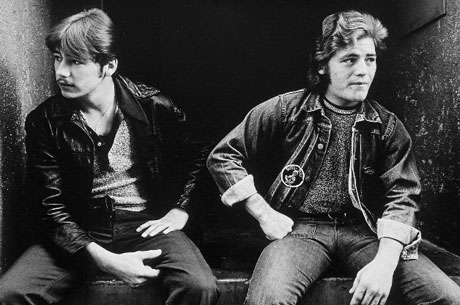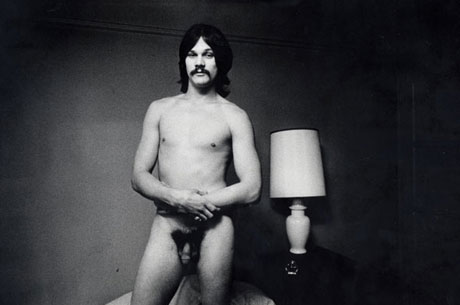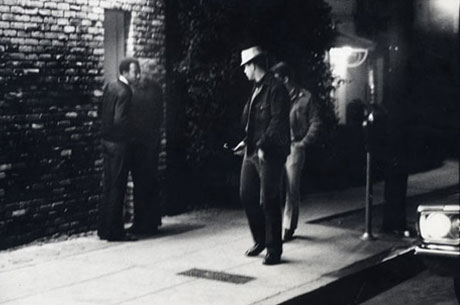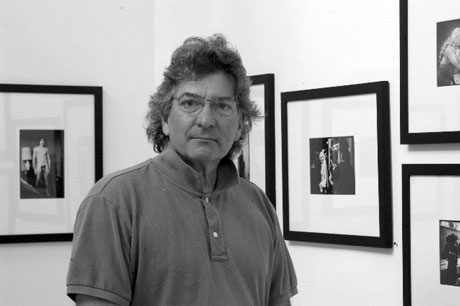|
 Hustlers,
Selma Avenue, Hollywood 1971 Hustlers,
Selma Avenue, Hollywood 1971
11x14 Vintage Silver-gelatin print
drkrm.gallery
is pleased to announce the exhibition of Anthony Friedkin's Gay,
A Photographic Essay 1969 - 1972 in commemoration
of the 40th Anniversary of the Stonewall Riot and Gay Pride month.
The exhibit will be on view at the drkrm. gallery from June 20th
to August 2nd, 2009. There will be a reception honoring the photographer
on Saturday June 20 from 7-10pm.
This retrospective exhibition of photographs about the Gay community
revisits work done by celebrated Los Angeles based photographer
Anthony Friedkin. This powerful and important set of vintage photographs,
over 35 years old, historically documents what was then the emerging
identity of the homosexual community, and the beginnings of the
Gay Liberation Movement. First displayed in a Los Angeles exhibit
in 1973 and later again in 1994 it's been over fifteen years since
these unique and beautifully printed vintage photographs have been
on view.
In
1969 when he was still a student, Friedkin embarked on The Gay
Essay. A series of pictures made in Los Angeles and San Francisco
that is the first extensive record of the Gay communities in these
cities. This work is an early example of the influence of Diane
Arbus outside NY, examining as it does the underbelly of a vibrant
and yet marginalized community. The Gay Essay functions
as a time capsule and a valuable historic record of a fiercely proud
community struggling for acceptance and integration.

Divine, Palace Theatre, San Francisco 1972
11x14 Vintage Silver-gelatin print
The essay shows Gay men and women both proudly and intensely living
an openly Gay lifestyle. "They were defining their sense of
freedom and individuality," says Friedkin, who choose at the
time to portray Gay people who refused to conform to society's values.
"I wanted to depict their struggles, humiliations, and their
triumphs."
The images in the exhibit depict a wide-ranging composite of gay
life: young hustlers, drag queens, transsexuals, San Francisco entertainers;
a Gay Liberation parade in Hollywood; two lesbian women very much
in love; effeminate boys growing up in an environment of machismo
and the religious subculture typical of East Los Angeles. Also included
are portraits of of Gay activists Morris Kight and Don Kilhefner,
Troy Perry, a Gay cleric, standing among the burned-down remains
of his downtown church after a suspected arson fire. A reviewer
from San Francisco's Artweek said of Friedkin's original
1973 exhibit: "The Gay Essay is comparable in magnitude
to Robert Frank's 'The Americans'...the exhibit in its entirety
is amazingly strong. And for the most part the photographs are singularly
beautiful in execution."
 Dan, Male
prostitute, San Fernando Valley,1972 Dan, Male
prostitute, San Fernando Valley,1972
11x14 Vintage Silver-gelatin print
The essay was published in Europe long before it was published in
the United States, due to the American media's reluctance to deal
with the images of a sensitive nature and the homosexual issue in
general. Re-exhibiting The Gay Essay today close to forty
years after it came into existence, powerfully illustrates and preserves
a crucial period in the Gay community's history.
A
native of Los Angeles, Anthony Friedkin began photographing as a
child. He started working in the darkroom at age eleven, processing
and printing his own images. Since that time, which was in the early
1960's, he has accomplished a significant body of work. His photographs
are included in major Museum collections: New York's Museum
of Modern Art, The J. Paul Getty Museum and others.
He is represented in numerous private collections as well. His work
has been exhibited world wide and has been published in Rolling
Stone, Zoom, Time, Newsweek. and many others.

Vice Police interrogating two men, Hollywood, 1972
11x14 Vintage Silver-gelatin print
Friedkin uses his camera as a means of personal discovery. His full
frame black & white photographs explore the many mysteries of
moments in time. He creates his own distinctive exhibition prints
in his darkroom. He says of his work, "I believe in extraordinary
photographs that draw you in and cannot be easily defined-celebrating
perception and its many hidden layers of reality."

Anthony Friedkin
Informed by the works of Atget, Kertesz, and Josef Koudelka, Friedkin
moves gracefully among disparate worlds--from surrealistic sets
of Hollywood to the shores of the tempestuous Pacific Ocean. Julian
Cox, from the Department of Photographs at the J. Paul Getty
Museum, writing in the introduction of Friedkin's photographic
Art book Timekeeper, said, "He captures and creates
beauty for its own sake, but he also chases life's more elusive
mysteries, The best of his pictures are outre, edgy fragments of
life, emitting sparks of electricity that increase in wattage the
more closely we examine what's there."
Click
here to read review

drkrm, in cooperation with the Steven Cohen Gallery is proud to
present this historic and groundbreaking body of work.
home |

 Hustlers,
Selma Avenue, Hollywood 1971
Hustlers,
Selma Avenue, Hollywood 1971
 Dan, Male
prostitute, San Fernando Valley,1972
Dan, Male
prostitute, San Fernando Valley,1972
